Research on Quality Detection of Jujube (Ziziphus jujuba Mill.) Fruit Based on UAV Multi-Spectrum
Abstract
1. Introduction
2. Materials and Methods
2.1. Collection of Samples
2.2. Experimental Equipment
2.3. Collection of Multispectral Images
2.4. Multispectral Image Preprocessing
2.4.1. Image Registration and Synthesis
2.4.2. Image Flat Field Correction
2.5. Determination of Physical and Chemical Values of Jujube Fruit
2.6. Abnormal Sample Elimination
2.7. Multispectral Continuum Removal Processing
2.8. Model Construction Method
3. Results
3.1. Multi-Angle Reflectance Analysis of Jujube Fruit
3.2. The Influence of Relative Azimuth Angle on the Prediction Results
3.2.1. The Influence of Relative Azimuth Angle on MC Prediction Results
3.2.2. The Influence of Relative Azimuth Angle on the Prediction Model of SSC
3.3. Establishment and Results of Jujube Fruit Quality Prediction Model Based on Multi-Angle Fusion
4. Discussion
5. Conclusions
Author Contributions
Funding
Institutional Review Board Statement
Informed Consent Statement
Data Availability Statement
Acknowledgments
Conflicts of Interest
References
- Ma, B.; Yan, J.; Wang, L.; Jiang, H. Method for Detection and Skeleton of Pruning Branch of Jujube Tree Based on Semantic Segmentation for Dormant Pruning. Trans. Chin. Soc. Agr. Mach. 2022, 53, 313–319. [Google Scholar]
- Wu, Z.; Zhang, S.; Liu, L.; Wang, L.; Ban, Z. The Grade of Dried Jujube (Ziziphus jujuba Mill. cv. Junzao) Affects Its Quality Attributes, Antioxidant Activity, and Volatile Aroma Components. Foods 2023, 12, 989. [Google Scholar] [CrossRef] [PubMed]
- Yao, Y.-N.; Ma, K.; Zhu, J.F.; Huang, F.; Kuang, L.; Wang, X.J.; Li, S. Non-destructive determination of soluble solids content in intact apples using a self-made portable NIR diffuse reflectance instrument. Infrared Phys. Technol. 2023, 132, 104714. [Google Scholar] [CrossRef]
- Cao, Y.X.; Yao, X.D.; Zang, Y.Z.; Niu, Y.B.; Xiao, H.W.; Liu, H.; Zhu, R.G.; Zheng, X.; Wang, Q.; Zhang, X.; et al. Real-time monitoring system for quality monitoring of jujube slice during drying process. Int. J. Agric. Biol. Eng. 2022, 15, 234–241. [Google Scholar] [CrossRef]
- Hao, Y.; Du, J.; Zhang, S.; Wang, Q. Research on Construction of Visible-Near Infrared Spectroscopy Analysis Model for Sol-uble Solid Content in Different Colors of Jujube. Spectrosc. Spect. Anal. 2021, 41, 3385–3391. [Google Scholar]
- Gallardo-Salazar, J.L.; Carrillo-Aguilar, D.M.; Pompa-García, M.; Aguirre-Salado, C.A. Multispectral indices and individual-tree level attributes explain forest productivity in a pine clonal orchard of Northern Mexico. Geocarto Int. 2022, 37, 4441–4453. [Google Scholar] [CrossRef]
- Martinez-Casasnovas, J.A.; Sandonis-Pozo, L.; Escola, A.; Arno, J.; Llorens, J. Delineation of Management Zones in Hedge-row Almond Orchards Based on Vegetation Indices from UAV Images Validated by LiDAR-Derived Canopy Parameters. Agronomy 2022, 12, 102. [Google Scholar] [CrossRef]
- Lima, F.; Blanco-Sepúlveda, R.; Gómez-Moreno, M.L.; Dorado, J.; Peña, J.M. Mapping tillage direction and contour farming by object-based analysis of UAV images. Comput. Electron. Agric. 2021, 187, 106281. [Google Scholar] [CrossRef]
- Vandermaesen, J.; Delalieux, S.; Bylemans, D.; Remy, S. Variable rate irrigation based on UAV imagery and real-time sensor data in pear orchards. In Proceedings of the 13th European Conference on Precision Agriculture (ECPA), Budapest, Hungary, 19–22 July 2021. [Google Scholar]
- Chen, R.Q.; Zhang, C.J.; Xu, B.; Zhu, Y.H.; Zhao, F.; Han, S.Y.; Yang, G.J.; Yang, H. Predicting individual apple tree yield using UAV multi-source remote sensing data and ensemble learning. Comput. Electron. Agric. 2022, 201, 107275. [Google Scholar] [CrossRef]
- Sun, G.X.; Wang, X.C.; Yang, H.H.; Zhang, X.J. A Canopy Information Measurement Method for Modern Standardized Ap-ple Orchards Based on UAV Multimodal Information. Sensors 2020, 20, 2985. [Google Scholar] [CrossRef]
- Bulanon, D.M.; Lonai, J.; Skovgard, H.; Fallahi, E. Evaluation of Different Irrigation Methods for an Apple Orchard Using an Aerial Imaging System. ISPRS Int. J. Geo-Inf. 2016, 5, 79. [Google Scholar] [CrossRef]
- Sandonís-Pozo, L.; Llorens, J.; Escolà, A.; Arnó, J.; Pascual, M.; Martínez-Casasnovas, J.A. Satellite multispectral indices to estimate canopy parameters and within-field management zones in super-intensive almond orchards. Precis. Agric. 2022, 23, 2040–2062. [Google Scholar] [CrossRef]
- Park, S.; Ryu, D.; Fuentes, S.; Chung, H.; O’connell, M.; Kim, J. Mapping Very-High-Resolution Evapotranspiration from Unmanned Aerial Vehicle (UAV) Imagery. ISPRS Int. J. Geo-Inf. 2021, 10, 211. [Google Scholar] [CrossRef]
- Santos-Rufo, A.; Mesas-Carrascosa, F.J.; Garcia-Ferrer, A.; Merono-Larriva, J.E. Wavelength Selection Method Based on Par-tial Least Square from Hyperspectral Unmanned Aerial Vehicle Orthomosaic of Irrigated Olive Orchards. Remote Sens. 2020, 12, 3426. [Google Scholar] [CrossRef]
- DadrasJavan, F.; Samadzadegan, F.; Pourazar, S.H.S.; Fazeli, H. UAV-based multispectral imagery for fast Citrus Greening detection. J. Plant Dis. Prot. 2019, 126, 307–318. [Google Scholar] [CrossRef]
- Lan, Y.B.; Huang, Z.X.; Deng, X.L.; Zhu, Z.H.; Huang, H.S.; Zheng, Z.; Lian, B.; Zeng, G.; Tong, Z.J. Comparison of machine learning methods for citrus greening detection on UAV multispectral images. Comput. Electron. Agric. 2020, 171, 105234. [Google Scholar] [CrossRef]
- Sun, G.Z.; Hu, T.T.; Chen, S.H.; Sun, J.X.; Zhang, J.; Ye, R.; Zhang, S.; Liu, J. Using UAV-based multispectral remote sensing imagery combined with DRIS method to diagnose leaf nitrogen nutrition status in a fertigated apple orchard. Precis. Agric. 2023, 24, 2522–2548. [Google Scholar] [CrossRef]
- Peng, X.L.; Chen, D.Y.; Zhou, Z.J.; Zhang, Z.T.; Xu, C.; Zha, Q.; Hu, X.T. Prediction of the Nitrogen, Phosphorus and Potas-sium Contents in Grape Leaves at Different Growth Stages Based on UAV Multispectral Remote Sensing. Remote Sens. 2022, 14, 2659. [Google Scholar] [CrossRef]
- Guan, Y.Y.; Grote, K.; Schott, J.; Leverett, K. Prediction of Soil Water Content and Electrical Conductivity Using Random Forest Methods with UAV Multispectral and Ground-Coupled Geophysical Data. Remote Sens. 2022, 14, 1023. [Google Scholar] [CrossRef]
- Pineda, D.; Perez, J.; Gaviria, D.; Ospino-Villalba, K.; Camargo, O. MEDUSA: An open-source and webcam based multispec-tral imaging system. Hardwarex 2022, 11, e00282. [Google Scholar] [CrossRef]
- Zahiri, Z.; Laefer, D.F.; Kurz, T.; Buckley, S.; Gowen, A. A comparison of ground-based hyperspectral imaging and red-edge multispectral imaging for façade material classification. Autom. Constr. 2022, 136, 104164. [Google Scholar] [CrossRef]
- Bleasdale, A.J.; Blackburn, G.A.; Whyatt, J.D. Feasibility of detecting apple scab infections using low-cost sensors and inter-preting radiation interactions with scab lesions. Int. J. Remote Sens. 2022, 43, 4984–5005. [Google Scholar] [CrossRef]
- Zhao, X.L.; Peng, Y.K.; Li, Y.Y.; Wang, Y.L.; Li, Y.; Chen, Y.H. Intelligent micro flight sensing system for detecting the internal and external quality of apples on the tree. Comput. Electron. Agric. 2023, 204, 107571. [Google Scholar] [CrossRef]
- Liu, J.K.; Zhu, Y.J.; Tao, X.Y.; Chen, X.F.; Li, X.W. Rapid prediction of winter wheat yield and nitrogen use efficiency using consumer-grade unmanned aerial vehicles multispectral imagery. Front. Plant Sci. 2022, 13, 1032170. [Google Scholar] [CrossRef] [PubMed]
- Huang, F.; Chen, Y.T.; Wang, X.S.; Wang, S.; Wu, X.Y. Spectral Clustering Super-Resolution Imaging Based on Multispectral Camera Array. IEEE Trans. Image Process. 2023, 32, 1257–1271. [Google Scholar] [CrossRef] [PubMed]
- Jhan, J.P.; Rau, J.Y. A Generalized Tool for Accurate and Efficient Image Registration of UAV Multi-lens Multispectral Cam-eras by N-SURF Matching. IEEE J.-Stars 2021, 14, 6353–6362. [Google Scholar]
- Meng, L.X.; Zhou, J.; Liu, S.M.; Ding, L.R.; Zhang, J.R.; Wang, S.F.; Lei, T.J. Investigation and evaluation of algorithms for unmanned aerial vehicle multispectral image registration. Int. J. Appl. Earth Obs. Geoinf. 2021, 102, 102403. [Google Scholar] [CrossRef]
- Nawara, T.J.; Williams, Y.D.; Rao, T.C.; Hu, Y.S.; Sztul, E.; Salaita, K.; Mattheyses, A.L. Imaging vesicle formation dynamics supports the flexible model of clathrin-mediated endocytosis. Nat. Commun. 2022, 13, 1732. [Google Scholar] [CrossRef] [PubMed]
- Bal, A.; Palus, H. A Smooth Non-Iterative Local Polynomial (SNILP) Model of Image Vignetting. Sensors 2021, 21, 7086. [Google Scholar] [CrossRef]
- Wang, Y.K.; Gu, Y.F.; Li, X.M. A Novel Low Rank Smooth Flat-Field Correction Algorithm for Hyperspectral Microscopy Imaging. IEEE Trans. Med. Imaging 2022, 41, 3862–3872. [Google Scholar] [CrossRef]
- Zhang, Y.B.; Zhu, D.D.; Chen, Y.; Liu, Z.; Duan, W.B.; Li, S.H. Wavelength Selection Method of Algal Fluorescence Spectrum Based on Convex Point Extraction From Feature Region. Spectrosc. Spectr. Anal. 2022, 42, 3031–3038. [Google Scholar]
- Basile, T.; Marsico, A.D.; Perniola, R. Use of Artificial Neural Networks and NIR Spectroscopy for Non-Destructive Grape Texture Prediction. Foods 2022, 11, 281. [Google Scholar] [CrossRef] [PubMed]
- Benelli, A.; Cevoli, C.; Ragni, L.; Fabbri, A. In-field and non-destructive monitoring of grapes maturity by hyperspectral imag-ing. Biosyst. Eng. 2021, 207, 59–67. [Google Scholar] [CrossRef]
- Li, Y. Rapid Quality Discrimination of Grape Seed Oil Using an Extreme Machine Learning Approach with Near-Infrared (NIR) Spectroscopy. Spectroscopy 2021, 36, 14–20. [Google Scholar]
- Ye, W.X.; Yan, T.Y.; Zhang, C.; Duan, L.; Chen, W.; Song, H. Detection of Pesticide Residue Level in Grape Using Hyperspec-tral Imaging with Machine Learning. Foods 2022, 11, 1609. [Google Scholar] [CrossRef] [PubMed]
- Marin, W.; Mondragon, I.F.; Colorado, J.D. Aerial Identification of Fruit Maturity in Amazonian Palms via Plant-Canopy Modeling. Remote. Sens. 2023, 15, 3752. [Google Scholar] [CrossRef]
- Arapostathi, E.; Panopoulou, C.; Antonopoulos, A.; Katsileros, A.; Karellas, K.; Dimopoulos, C.; Tsagkarakis, A. Early Detec-tion of Potential Infestation by Capnodis tenebrionis (L.) (Coleoptera: Buprestidae), in Stone and Pome Fruit Orchards, Using Multispectral Data from a UAV. Agronomy 2024, 14, 20. [Google Scholar] [CrossRef]
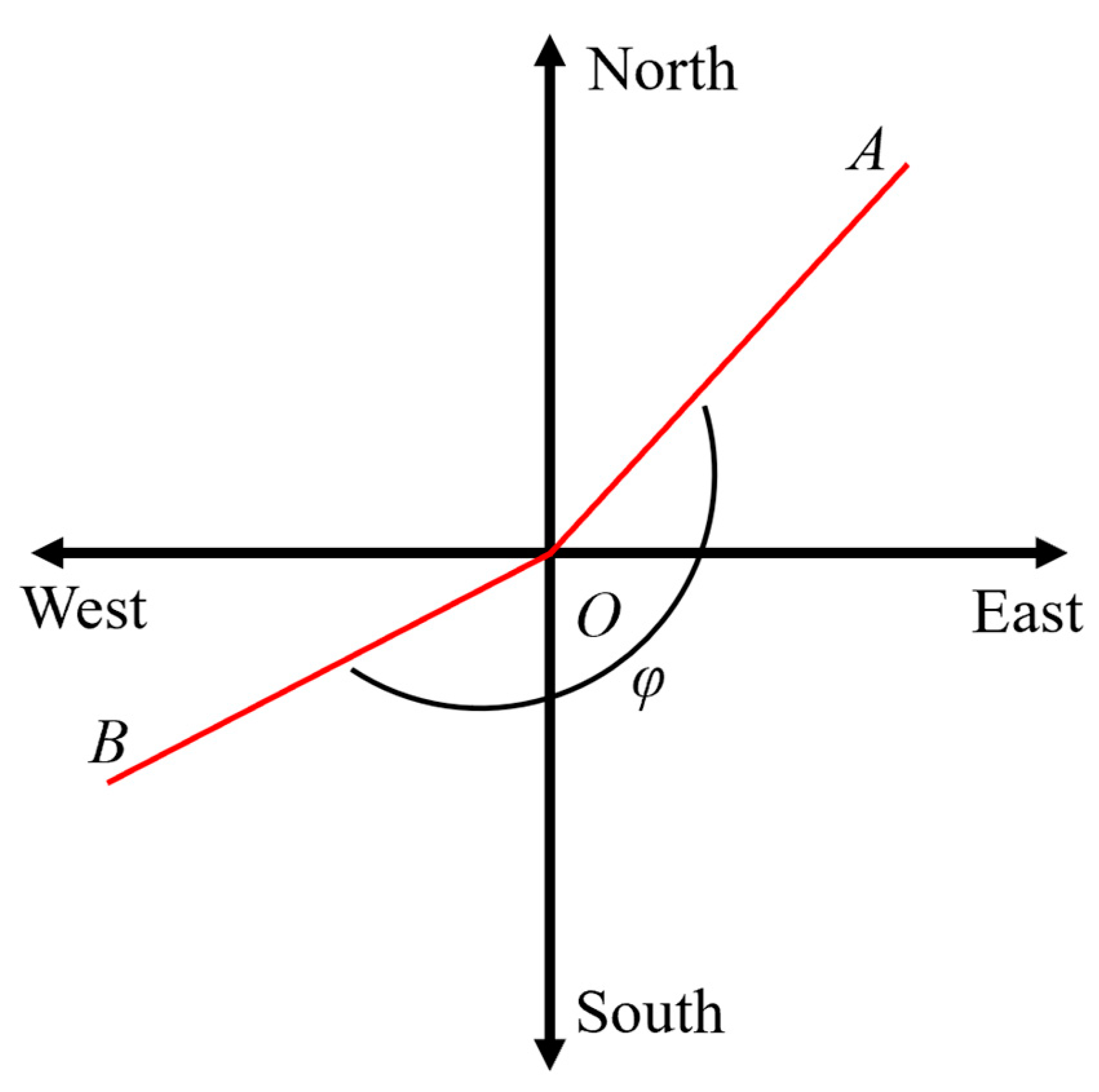
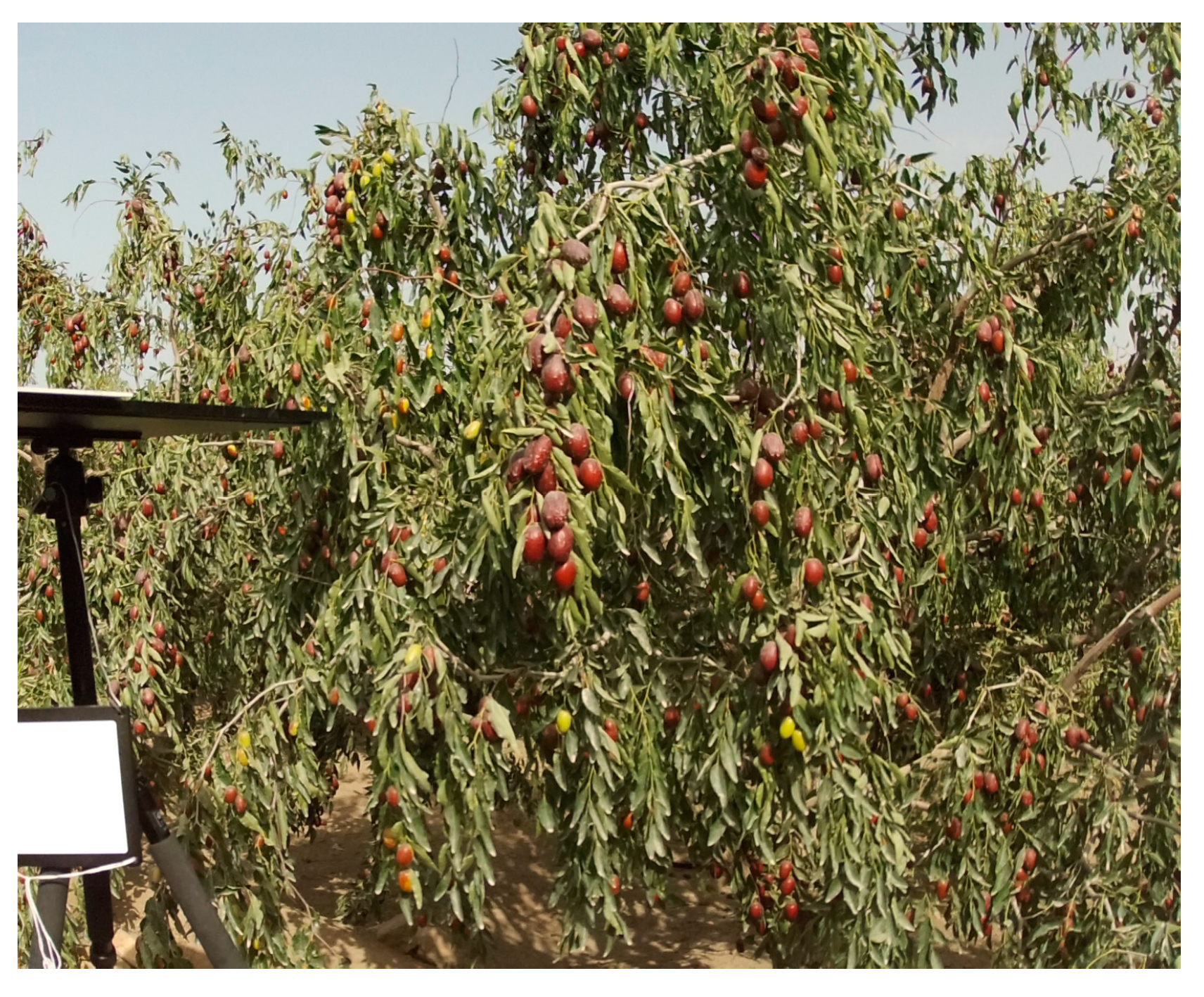
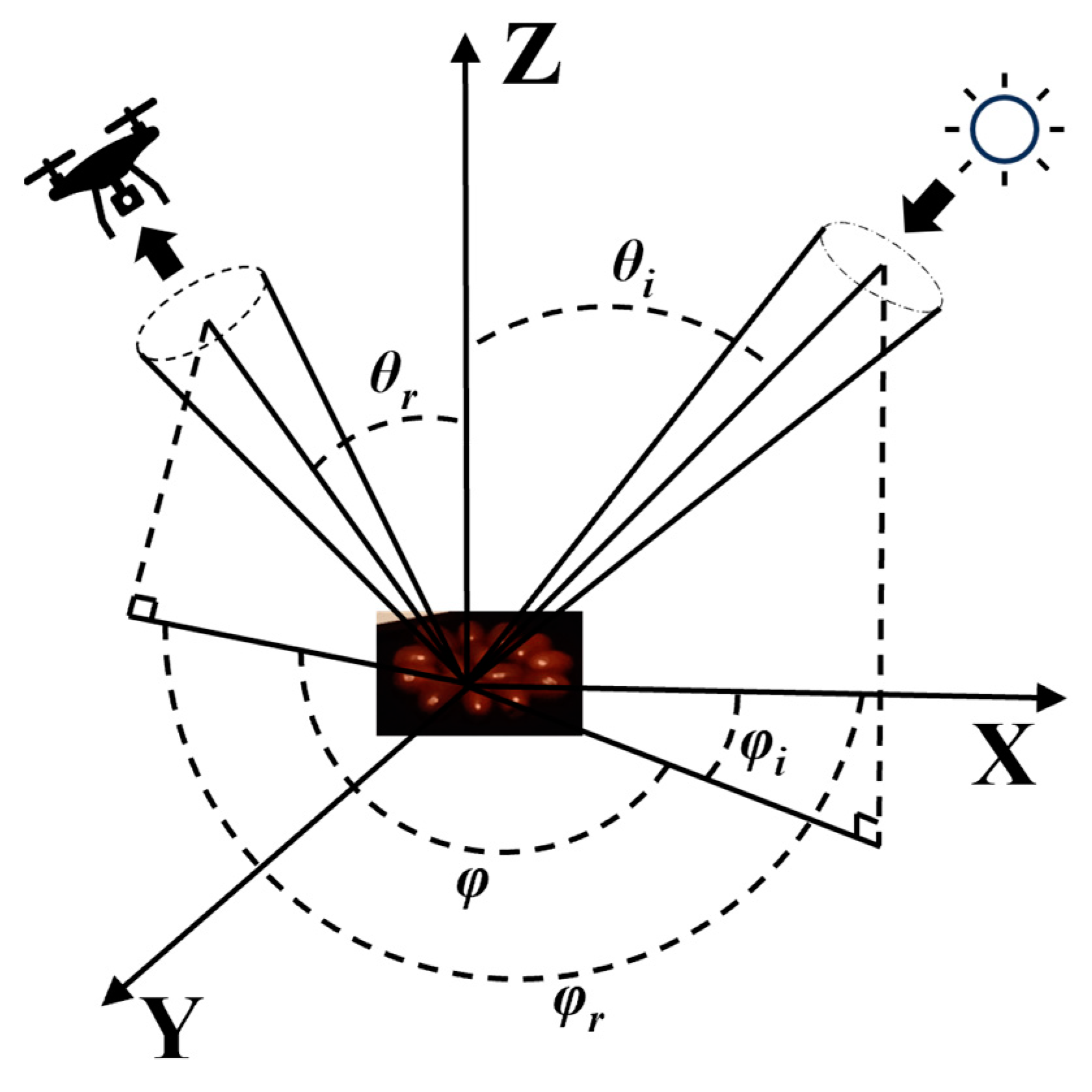

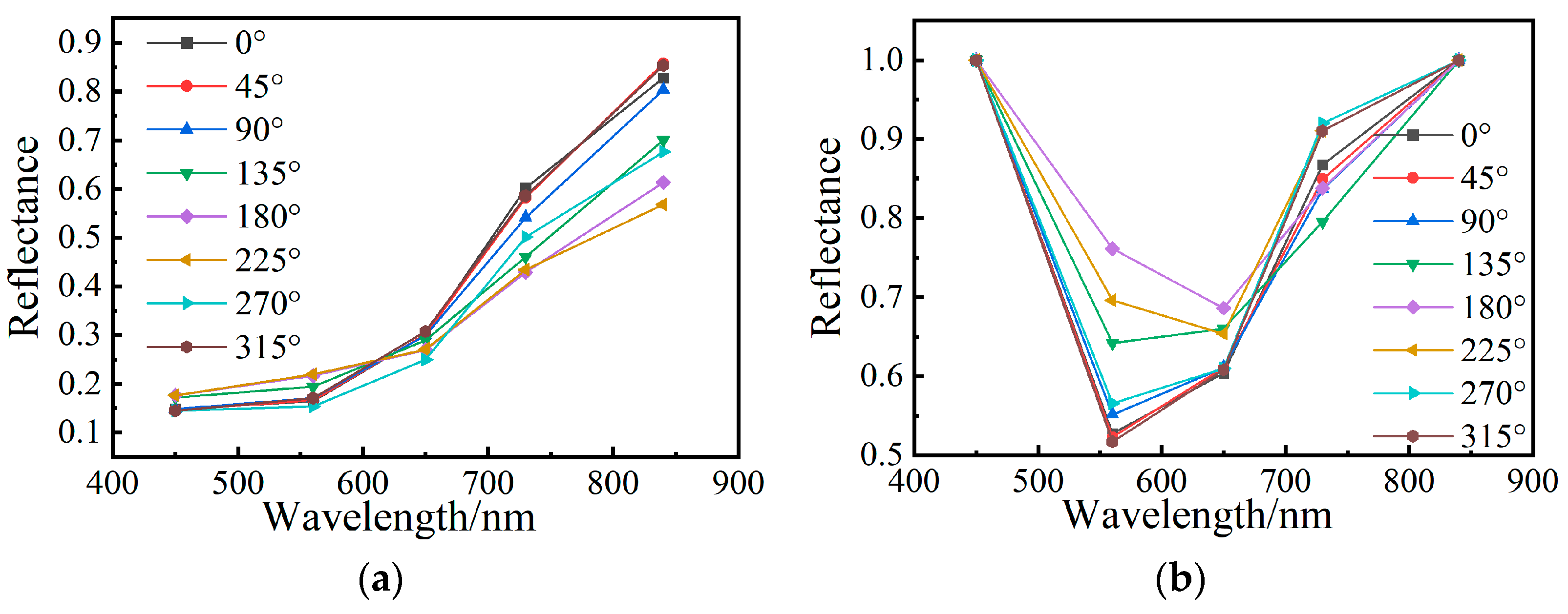
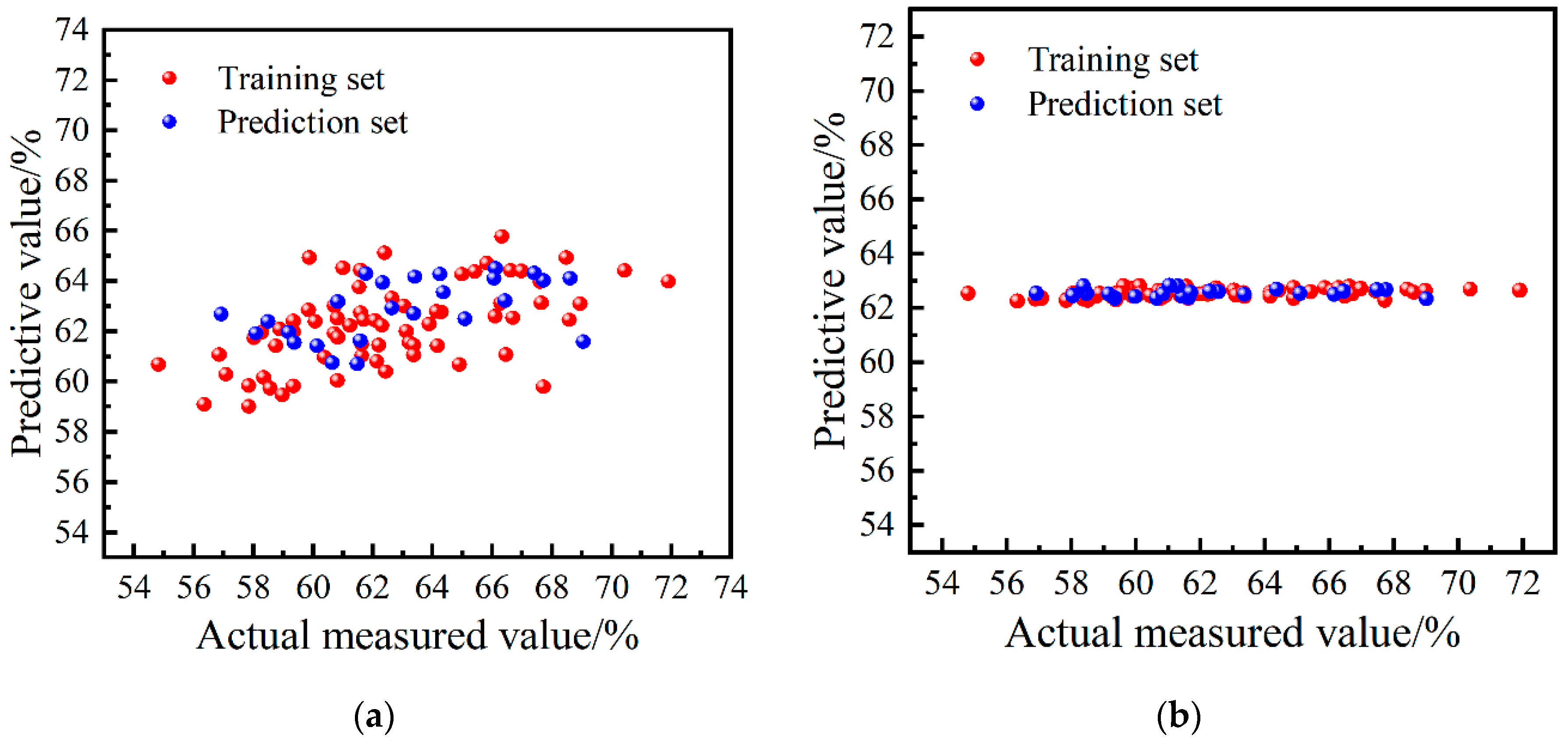


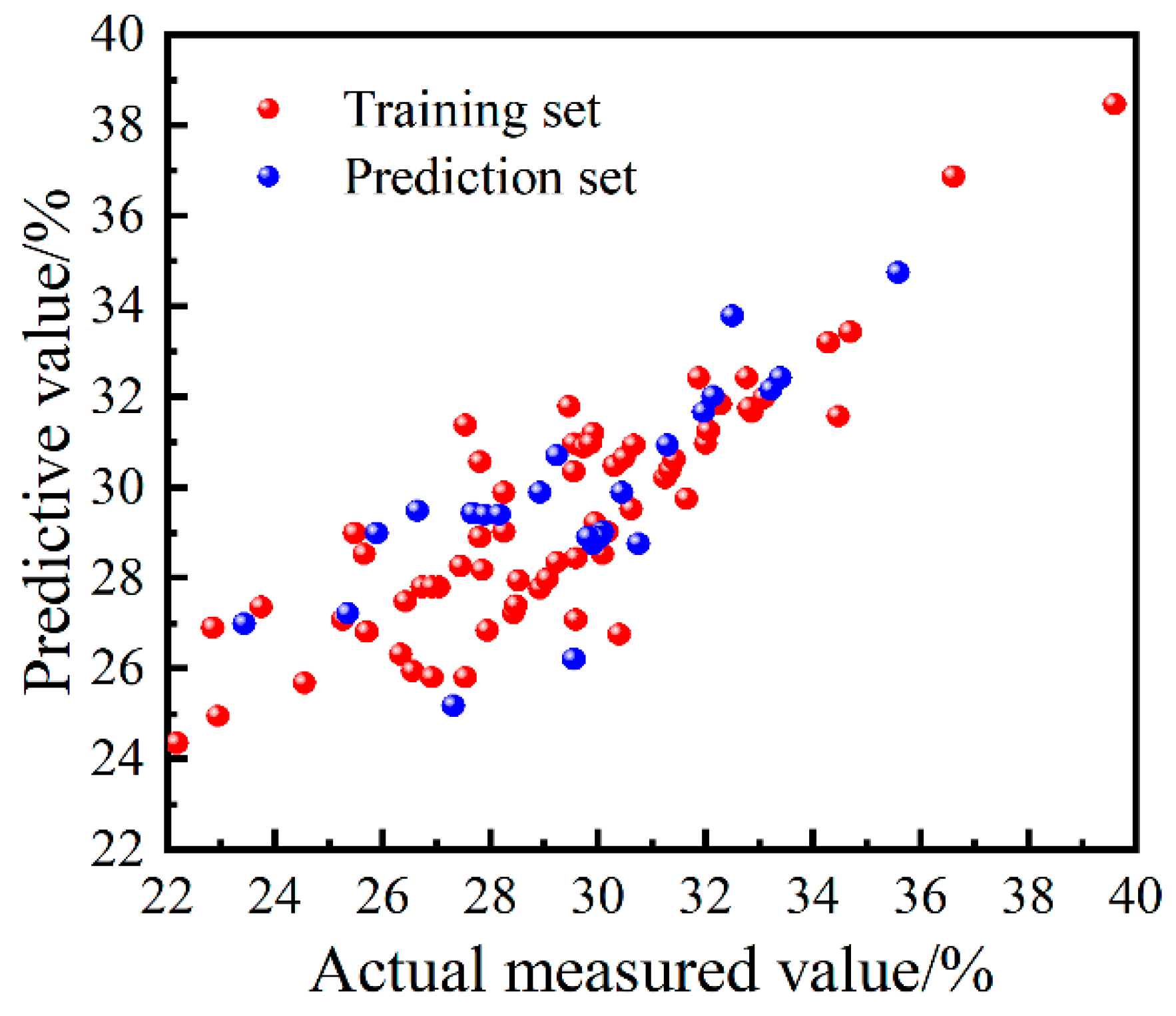
| Spectral Band | Center Wavelength/nm | Bandwidth/nm |
|---|---|---|
| Blue light | 450 | 16 |
| Green light | 560 | 16 |
| Red light | 650 | 16 |
| Red edge | 730 | 16 |
| Near-infrared | 840 | 26 |
| Index | Maximum Value | Minimum Value | Average Value | Standard Deviation | Coefficient of Variation |
|---|---|---|---|---|---|
| MC/% | 71.88 | 54.67 | 62.45 | 3.87 | 6.20 |
| SSC/% | 39.6 | 20.2 | 29.10 | 3.80 | 13.08 |
| Model | Relative Azimuth/° | Training Set | Prediction Set | ||
|---|---|---|---|---|---|
| Rc | RMSEC | Rp | RMSEP | ||
| PLSR | 0 | 0.2474 | 3.2755 | 0.2788 | 3.2263 |
| 45 | 0.3342 | 3.2092 | 0.2595 | 3.2407 | |
| 90 | 0.5798 | 2.7122 | 0.3733 | 3.1731 | |
| 135 | 0.2947 | 3.0731 | 0.3502 | 3.0611 | |
| 180 | 0.3381 | 3.2090 | 0.1887 | 3.3870 | |
| 225 | 0.3632 | 3.0566 | 0.1098 | 3.2212 | |
| 270 | 0.3123 | 3.2170 | 0.1294 | 2.9910 | |
| 315 | 0.1832 | 3.2663 | 0.0938 | 3.3545 | |
| SVM | 0 | 0.2224 | 3.3730 | 0.2760 | 3.2873 |
| 45 | 0.3362 | 3.3725 | 0.2744 | 3.3204 | |
| 90 | 0.5409 | 3.2294 | 0.5036 | 3.2907 | |
| 135 | 0.3000 | 3.1772 | 0.3388 | 3.1867 | |
| 180 | 0.3211 | 3.3983 | 0.1359 | 3.3822 | |
| 225 | 0.3058 | 3.2836 | 0.2694 | 3.1748 | |
| 270 | 0.2463 | 3.3401 | 0.4720 | 3.1074 | |
| 315 | 0.1887 | 3.3147 | 0.0523 | 3.3521 | |
| Model | Relative Azimuth/° | Training Set | Prediction Set | ||
|---|---|---|---|---|---|
| Rc | RMSEC | Rp | RMSEP | ||
| PLSR | 0 | 0.4529 | 2.5369 | 0.2619 | 2.4756 |
| 45 | 0.3908 | 2.5270 | 0.2192 | 2.6158 | |
| 90 | 0.4772 | 2.5119 | 0.3261 | 2.5302 | |
| 135 | 0.1194 | 2.7296 | 0.2185 | 2.4867 | |
| 180 | 0.4562 | 2.8416 | 0.4184 | 2.5181 | |
| 225 | 0.3344 | 2.5911 | 0.1921 | 2.5286 | |
| 270 | 0.3350 | 2.7338 | 0.4413 | 2.5535 | |
| 315 | 0.2671 | 2.6906 | 0.1714 | 2.7855 | |
| SVM | 0 | 0.3721 | 2.6939 | 0.2456 | 2.5508 |
| 45 | 0.3968 | 2.7055 | 0.2136 | 2.5377 | |
| 90 | 0.4125 | 2.8331 | 0.3253 | 2.5454 | |
| 135 | 0.0870 | 2.7455 | 0.0704 | 2.5352 | |
| 180 | 0.4141 | 3.1531 | 0.5176 | 2.6538 | |
| 225 | 0.3388 | 2.6934 | 0.2071 | 2.5095 | |
| 270 | 0.2788 | 2.8850 | 0.3432 | 2.8287 | |
| 315 | 0.2772 | 2.7681 | 0.2474 | 2.5761 | |
| Model | Relative Azimuth/° | Training Set | Prediction Set | ||
|---|---|---|---|---|---|
| Rc | RMSEC | Rp | RMSEP | ||
| MC | SA-PLSR | 0.5798 | 2.7122 | 0.3733 | 3.1731 |
| AF-PLSR | 0.9067 | 1.5510 | 0.8072 | 1.9935 | |
| SA-SVM | 0.5409 | 3.2294 | 0.5036 | 3.2907 | |
| AF-SVM | 0.9319 | 1.3379 | 0.7890 | 2.1368 | |
| SSC | SA-PLSR | 0.4562 | 2.8416 | 0.4184 | 2.5181 |
| AF-PLSR | 0.8562 | 1.6712 | 0.7283 | 2.0187 | |
| SA-SVM | 0.4141 | 3.1531 | 0.5176 | 2.6538 | |
| AF-SVM | 0.8624 | 1.6486 | 0.7663 | 1.8501 | |
Disclaimer/Publisher’s Note: The statements, opinions and data contained in all publications are solely those of the individual author(s) and contributor(s) and not of MDPI and/or the editor(s). MDPI and/or the editor(s) disclaim responsibility for any injury to people or property resulting from any ideas, methods, instructions or products referred to in the content. |
© 2024 by the authors. Licensee MDPI, Basel, Switzerland. This article is an open access article distributed under the terms and conditions of the Creative Commons Attribution (CC BY) license (https://creativecommons.org/licenses/by/4.0/).
Share and Cite
Ma, X.; Wang, C.; Luo, H.; Guo, G. Research on Quality Detection of Jujube (Ziziphus jujuba Mill.) Fruit Based on UAV Multi-Spectrum. Appl. Sci. 2024, 14, 2962. https://doi.org/10.3390/app14072962
Ma X, Wang C, Luo H, Guo G. Research on Quality Detection of Jujube (Ziziphus jujuba Mill.) Fruit Based on UAV Multi-Spectrum. Applied Sciences. 2024; 14(7):2962. https://doi.org/10.3390/app14072962
Chicago/Turabian StyleMa, Xueting, Congying Wang, Huaping Luo, and Ganggang Guo. 2024. "Research on Quality Detection of Jujube (Ziziphus jujuba Mill.) Fruit Based on UAV Multi-Spectrum" Applied Sciences 14, no. 7: 2962. https://doi.org/10.3390/app14072962
APA StyleMa, X., Wang, C., Luo, H., & Guo, G. (2024). Research on Quality Detection of Jujube (Ziziphus jujuba Mill.) Fruit Based on UAV Multi-Spectrum. Applied Sciences, 14(7), 2962. https://doi.org/10.3390/app14072962






